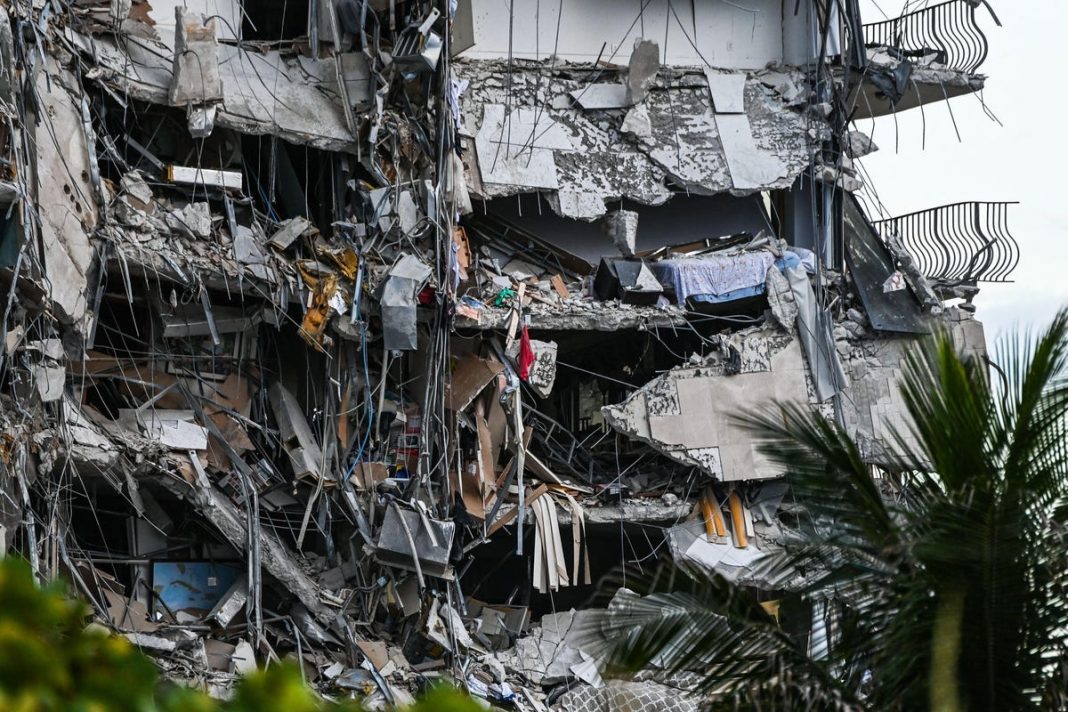Rubble hangs from a partially collapsed building in Surfside north of Miami Beach, on June 24, 2021. … [+]
AFP via Getty Images
It’s scary to think about what happened in Surfside, because the truth is that it could happen again, anywhere. That’s especially true as new “green” building technologies and materials come on to the market to reduce the enormous climate impact of buildings. This market is booming, estimated to rise to $433 billion by 2024, so we better know what they’re doing. Our lives depend upon it, literally.
Buildings are responsible for about 40% of the country’s carbon emissions and use about 40% of the country’s energy, according to the Environmental Protection Agency and the Energy Information Agency, so it’s a major focal point for industry experts, entrepreneurs and policymakers for mitigating climate change.
But as we all watched in horror as the Champlain Towers collapsed in Surfside, Florida recently, we have to ask about the safety and structural integrity of these new materials.
There are many issues to address in answering that question, including how they are tested for structural integrity, their composition, and how they interact with other materials in the building project.
The USGBC logo on the window of the 41 Cooper Square building. (Photo by: Jeffrey … [+]
Universal Images Group via Getty Images
Elizabeth Thompson, an architect and Vice President of the U.S. Green Building Council which developed the LEED-certifications that are considered a gold standard for environmentally-sound buildings, said that all buildings and materials go through a range of tests, so that an issue perhaps missed by one test will be revealed in another test. She also said that an integrated approach to building construction supports this, where all parties involved in it communicate often and openly to address any issues early, including regional climate issues.
One potential failure could be materials don’t interact well.
Structural engineer Frances Yang of global engineering, architecture and consulting firm Arup said that a lot of failures are “a very local phenomenon,” which is one that starts small in one part of the structure and then “propagates and leads to the kind of collapse that we saw.” These are prevented from rippling through and causing potentially dangerous issues through redundant systems in the structure, so that any failure is stopped early.
One of those potential local failures, Yang explained, could come from materials that do not interact well together, similar to when your doctor changes your medications because they may not interact well when you take them at the same time. So, how do we know what’s in these products?
How can builders know in advance?
About 700 manufacturers are publicly reporting the contents of their building materials through the Health Products Declaration Collaborative’s (HPDC) Open Standard, which was developed about 12 years ago in response to increasing demands from builders, architects and engineers for more transparency about these products.
Wendy Vittori, Executive Director, Health Product Declaration Collaborative
Health Product Declaration Collaborative
“Any product that is used to construct the building, finish the building, or furnish the building is comprehended within our standard,” Wendy Vittori, HPDC’s executive director explained on my podcast Green Connections Radio, including what chemicals are in it and the potential health and environmental impacts of it.” It is “standard across all products,” and they have over 8,600 products, or what she calls “HPDs.” “The Health Product Declaration Open Standard, or we use the term HPD for short, is a fairly detailed specification. It does two things. It says, what is the piece of information that we want? And secondly, it says exactly precisely how should a manufacturer report on that?”
These criteria are developed using what Vittori called “the consensus stakeholder method,” leveraging the expertise of the 300 member organizations in the HPDC and updating it annually to stay abreast of new developments. She explained their process this way: “We have technical committees and technical subgroups. So, the first underpinning of the validity is the standard itself. And the fact that it has been reviewed by a wide variety of people throughout the building industry that have expertise in the building products, in chemistry and toxicology and industrial hygiene, all of those disciplines, and then have agreed upon this standard,” and it is the same standard “no matter what type of product.” This enables builders and engineers to compare building products much like you would compare shoes or computers on an ecommerce site.
Sample Open Standard, from the Health Product Declaration Collaborative
Health Product Declaration Collaborative
“The standard is intelligent about the types of different products and if, and if something is required to understand the product, then the standard will have that,” she said, including “where there are different reporting needs in certain kinds of products.” This information includes the amount and kind of recycled content.
The information is also verified by independent organizations in what Vittori called their “approved verifiers program… where they go through training to make sure in addition to understanding the chemical and toxicological and other elements that they’re fully capable of understanding how to apply the HPD open standard to this data.”
Critical information for the health and safety of first responders – and city ordinance changes too
This disclosure can also help first responders understand potentially toxic materials they may be exposed to while sifting through and cleaning up the debris, which was a cause of so much secondary illness in the 9-11 first responders, for example.
Let’s hope the first responders who cleaned up the Surfside collapse had access to this information for their own protection.
It may also come into play as cities around the country, and maybe around the globe, are re-evaluating their city ordinances and building codes in light of the catastrophic, sudden and tragic Surfside collapse.
Listen to my full interview with Wendy Vittori of the Health Products Declaration Collaborative on my podcast, Green Connections Radio.




